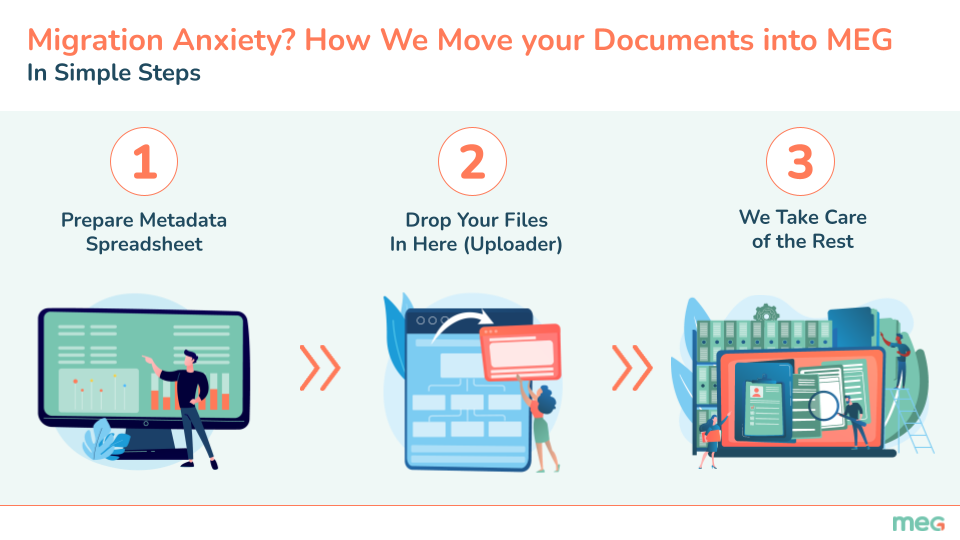💡 Free resources included at the end of this post: Download MEG’s Document Management Maturity Workbook and watch our on-demand webinar with Clare Harney and Leonora O’Brien.
In Part 1, we surfaced the “digital document graveyard” problem — policies uploaded but effectively buried, leaving frontline teams exposed and leaders firefighting avoidable risk.
In Part 2, we shifted to the solution: how integrated, healthcare-specific systems turn documents into a dynamic driver of quality and safety, tightening governance and putting the right version in the right hands at the point of care.
Now in Part 3, we take the leadership perspective. Drawing on insights from Clare Harney and Leonora O’Brien, we explore how directors of quality can move beyond tick-box compliance to build a culture of safety and accountability.
The Maturity Journey
Every organisation sits somewhere on the document management maturity curve, from basic storage, to controlled systems, to fully integrated and intelligence-driven quality management.
This is what we call the maturity journey. The five dimensions of maturity, access, versioning, governance, engagement, and integration, provide leaders with a practical way to measure where they are today, and where they need to go.
The 5 Dimensions of Document System Maturity
1. Access — From Hidden Files to Usable Guidance
Level 1: Documents scattered, staff can’t reliably find what they need.
Level 5: Intelligent search delivers the right policy at the right time.
Cultural impact: Access is about trust. If staff can’t find current SOPs, they fall back on habit or hearsay. When access is reliable, the message is clear: leaders care about enabling safe, consistent practice.
““When staff follow up-to-date, standardised protocols, care is safer and more predictable.”
”
2. Versioning — From Chaos to Confidence
Level 1: Multiple uncontrolled versions in circulation.
Level 5: Live versioning ensures a single, trusted source of truth.
Cultural impact: Consistency breeds confidence. When staff don’t trust documents, culture drifts into workarounds. Strong version control signals leadership discipline, what’s published is what’s practiced.
3. Governance — From Paper Trails to Real Accountability
Level 1: No oversight, approvals undocumented.
Level 5: Every approval, attestation, and change is tracked automatically.
Cultural impact: Governance is visible leadership. Transparent audit trails tell staff that leaders don’t just write policies, they own them. It reinforces accountability at every level.
““Every document action, who approved, who attested, and when, is tracked. That’s real governance.””
4. Engagement — From Compliance Chasing to Shared Responsibility
Level 1: Leaders can’t prove staff have read SOPs.
Level 5: Engagement dashboards show who’s read, who’s attested, and who needs follow-up.
Cultural impact: Engagement isn’t about nagging. It’s about shifting responsibility from compliance officers to every team member. Leaders who measure engagement are actually measuring culture of accountability.
5. Integration — From Silos to System-Wide Insight
Level 1: Policies, audits, risks, and training all managed in isolation.
Level 5: A fully connected quality ecosystem, where documents, audits, incidents, and training are dynamically linked.
Cultural impact: Integration is about connectedness. Leaders gain a holistic view of quality and safety — how policies, risks, training, and incidents interact and influence each other. This isn’t “box-checking” across separate modules; it’s comprehensive oversight that allows leaders to anticipate issues, understand cause and effect, and make proactive improvements.
““With MEG, everything is dynamically linked … SOPs, audits, training — one source of truth that’s accessible and reliable.” ”
Why Leaders Must Own the Maturity Journey
Moving up the maturity curve requires deliberate leadership. One of the biggest hurdles in the journey is migration: moving thousands of documents, often inconsistent, duplicated, or poorly tagged, out of legacy platforms like SharePoint and into a modern, integrated quality system. For many leaders, this feels daunting.
The key is to work with a vendor that has extensive experience in healthcare migrations. MEG has delivered this repeatedly, for example, DaVita International, a leading global provider of renal care operating over 400 centres across 13 countries, successfully migrated more than 5,000 documents into MEG through a streamlined process.
Migration isn’t just a technical task; it’s a leadership moment. It’s the opportunity to draw a line under fragmented systems, reset expectations, and set a higher standard of governance and culture. Done well, it becomes the first visible sign of change, showing staff that leaders are serious about moving beyond “document graveyards” to a culture of active quality improvement.
The Document Management Maturity Framework then provides the roadmap: benchmark your current state, define the target, and lead the organisation through each step of the journey.
This isn’t about IT. It’s about creating systems that staff can rely on and regulators can trust.
Practical Takeaways for Directors of Quality
Make documents cultural, not clerical. Staff must experience them as everyday guidance, not admin files.
Think holistically. Quality and safety require connectedness, not silos.
Use migration as a cultural reset. A moment to leave behind bad habits and build accountability.
Adopt the maturity framework. Progress step by step, from storage to governance, from compliance to culture.
Final Thought: From Storage to Leadership
Clare Harney put it simply: “You should be audit-ready at any time, not scrambling when inspectors arrive.”
That’s the essence of leadership in document management: creating systems that are always current, always accessible, and always aligned with safe care. For directors of quality, it’s not about storing documents, it’s about leading improvement.
📊 Next Step for Directors of Quality:
👉 [Click] Download the Document Management Maturity Workbook
👉 [Click] Watch the Document Management webinar with Clare & Leonora
👉 [Click] Book a leadership demo of MEG

